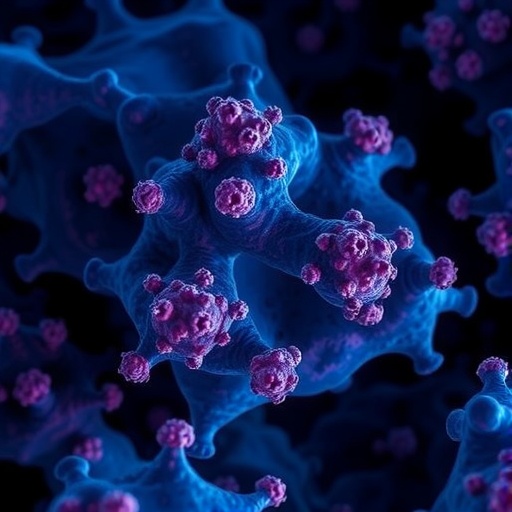A large clinical trial of people living with HIV has found that treating anal precancerous growths known as high-grade squamous intraepithelial lesions, or HSIL, reduces the chance that anal cancer will develop by more than half.

Credit: The ANCHOR study
A large clinical trial of people living with HIV has found that treating anal precancerous growths known as high-grade squamous intraepithelial lesions, or HSIL, reduces the chance that anal cancer will develop by more than half.
Results from the Anal Cancer/HSIL Outcomes Research (ANCHOR) study were published June 16 in the New England Journal of Medicine. The trial was funded by the National Cancer Institute (NCI), part of the National Institutes of Health.
“We’ve now shown for the first time that treating anal HSIL is effective at reducing the incidence of anal cancer in a very high-risk group of people — people living with HIV,” said Joel Palefsky, M.D., of the University of California, San Francisco, who led the study.
“By showing that treatment for HSIL reduces the risk of anal cancer, this study also provides a rationale for screening for anal HSIL in people with HIV,” said Robert Yarchoan, M.D., director of NCI’s Office of HIV and AIDS Malignancy. The trial was conducted through the NCI-supported AIDS Malignancy Consortium.
Although anal cancer is relatively rare in the general population, it is the fourth most common cancer among people living with HIV. The incidence of anal cancer is estimated to be 89 per 100,000 among men living with HIV who have sex with men and between 18.6 and 35.6 per 100,000 among women living with HIV. In comparison, the incidence of anal cancer in the general population is 1.6 per 100,000.
Nearly all cases of anal cancer are caused by infection of anal cells with cancer-causing types of human papillomavirus (HPV). If the immune system does not fight off the infection, the lingering infection can cause the cells to become progressively more abnormal, ultimately developing into HSIL and then, in some cases, into anal cancer. This progression is similar to what is seen in cervical cancer, which is also caused by HPV.
Although HPV vaccination can prevent new anal HPV infections, no evidence-based recommendations are currently available to guide screening for and treatment of anal HSIL.
Routine screening for cervical cancer with HPV and/or Pap testing and removing cervical HSIL has been shown to prevent many cases of cervical cancer. However, it has been unclear whether the treatment of anal HSIL found through screening similarly prevents anal cancer. Moreover, the treatment of anal HSIL is more challenging than the treatment of cervical HSIL, and recurrences are common.
The ANCHOR study is the first randomized controlled trial to determine whether treating anal HSIL is a safe and effective strategy for reducing the progression of HSIL to anal cancer.
In the phase 3 trial, which was carried out at 25 sites nationwide, 10,723 people age 35 or older living with HIV underwent screening for HSIL with high-resolution anoscopy, a procedure to examine the inner lining of the anus and rectum. Of these, 4,459 people were diagnosed with HSIL. People in this group were then randomly assigned to receive treatment or to receive active monitoring with no treatment, the current standard of care. Most people in the treatment group received office-based electrocautery, a procedure in which heat from an electric current is used to destroy abnormal tissue.
After a median follow-up of just over two years, 21 people in the active monitoring group were diagnosed with anal cancer, compared with nine people in the treatment group — a 57% reduction. The majority of the side effects in the treatment group were mild and included pain and bleeding.
“The data support treating anal HSIL as the standard of care for people living with HIV who are 35 years of age or older,” said Dr. Palefsky.
He noted that the findings could also potentially lead to recommendations for screening for HSIL in people living with HIV and might also change the standard of care for other groups at lower but still increased risk of anal cancer, including HIV-negative men who have sex with men, women who have had other HPV-related precancers or cancers, and people who are immunosuppressed after organ transplantation or other reasons.
The authors noted that the clinicians participating in the study were well trained in high-resolution anoscopy and in treating HSIL. “Our results may not be replicated if high-resolution anoscopy and treatment are performed by clinicians with less training and clinical support,” the researchers wrote.
Dr. Palefsky said the findings highlight the need for additional training of clinicians, as well as more research on effective approaches for screening and treating HSIL.
“Although we did show a statistically significant reduction in anal cancer due to treatment, we did not prevent all the cases of cancer,” Dr. Palefsky noted. “What that points to is a need for ongoing follow-up of everybody who has developed anal HSIL, even if they’ve been treated, as well as for improvements in the treatments that we use.”
As for next steps in the study, Dr. Palefsky said they have developed a biorepository of tissue samples from the study participants. These samples will be analyzed to help identify possible biomarkers for who should be screened for HSIL and to investigate the biology behind how HSIL progresses to anal cancer.
“This study will give an absolute wealth of information about anal cancer,” Dr. Yarchoan said.
A large clinical trial of people living with HIV has found that treating anal precancerous growths known as high-grade squamous intraepithelial lesions, or HSIL, reduces the chance that anal cancer will develop by more than half.
Results from the Anal Cancer/HSIL Outcomes Research (ANCHOR) study were published June 16 in the New England Journal of Medicine. The trial was funded by the National Cancer Institute (NCI), part of the National Institutes of Health.
“We’ve now shown for the first time that treating anal HSIL is effective at reducing the incidence of anal cancer in a very high-risk group of people — people living with HIV,” said Joel Palefsky, M.D., of the University of California, San Francisco, who led the study.
“By showing that treatment for HSIL reduces the risk of anal cancer, this study also provides a rationale for screening for anal HSIL in people with HIV,” said Robert Yarchoan, M.D., director of NCI’s Office of HIV and AIDS Malignancy. The trial was conducted through the NCI-supported AIDS Malignancy Consortium.
Although anal cancer is relatively rare in the general population, it is the fourth most common cancer among people living with HIV. The incidence of anal cancer is estimated to be 89 per 100,000 among men living with HIV who have sex with men and between 18.6 and 35.6 per 100,000 among women living with HIV. In comparison, the incidence of anal cancer in the general population is 1.6 per 100,000.
Nearly all cases of anal cancer are caused by infection of anal cells with cancer-causing types of human papillomavirus (HPV). If the immune system does not fight off the infection, the lingering infection can cause the cells to become progressively more abnormal, ultimately developing into HSIL and then, in some cases, into anal cancer. This progression is similar to what is seen in cervical cancer, which is also caused by HPV.
Although HPV vaccination can prevent new anal HPV infections, no evidence-based recommendations are currently available to guide screening for and treatment of anal HSIL.
Routine screening for cervical cancer with HPV and/or Pap testing and removing cervical HSIL has been shown to prevent many cases of cervical cancer. However, it has been unclear whether the treatment of anal HSIL found through screening similarly prevents anal cancer. Moreover, the treatment of anal HSIL is more challenging than the treatment of cervical HSIL, and recurrences are common.
The ANCHOR study is the first randomized controlled trial to determine whether treating anal HSIL is a safe and effective strategy for reducing the progression of HSIL to anal cancer.
In the phase 3 trial, which was carried out at 25 sites nationwide, 10,723 people age 35 or older living with HIV underwent screening for HSIL with high-resolution anoscopy, a procedure to examine the inner lining of the anus and rectum. Of these, 4,459 people were diagnosed with HSIL. People in this group were then randomly assigned to receive treatment or to receive active monitoring with no treatment, the current standard of care. Most people in the treatment group received office-based electrocautery, a procedure in which heat from an electric current is used to destroy abnormal tissue.
After a median follow-up of just over two years, 21 people in the active monitoring group were diagnosed with anal cancer, compared with nine people in the treatment group — a 57% reduction. The majority of the side effects in the treatment group were mild and included pain and bleeding.
“The data support treating anal HSIL as the standard of care for people living with HIV who are 35 years of age or older,” said Dr. Palefsky.
He noted that the findings could also potentially lead to recommendations for screening for HSIL in people living with HIV and might also change the standard of care for other groups at lower but still increased risk of anal cancer, including HIV-negative men who have sex with men, women who have had other HPV-related precancers or cancers, and people who are immunosuppressed after organ transplantation or other reasons.
The authors noted that the clinicians participating in the study were well trained in high-resolution anoscopy and in treating HSIL. “Our results may not be replicated if high-resolution anoscopy and treatment are performed by clinicians with less training and clinical support,” the researchers wrote.
Dr. Palefsky said the findings highlight the need for additional training of clinicians, as well as more research on effective approaches for screening and treating HSIL.
“Although we did show a statistically significant reduction in anal cancer due to treatment, we did not prevent all the cases of cancer,” Dr. Palefsky noted. “What that points to is a need for ongoing follow-up of everybody who has developed anal HSIL, even if they’ve been treated, as well as for improvements in the treatments that we use.”
As for next steps in the study, Dr. Palefsky said they have developed a biorepository of tissue samples from the study participants. These samples will be analyzed to help identify possible biomarkers for who should be screened for HSIL and to investigate the biology behind how HSIL progresses to anal cancer.
“This study will give an absolute wealth of information about anal cancer,” Dr. Yarchoan said.
Journal
New England Journal of Medicine
DOI
10.1056/NEJMoa2201048
Method of Research
Randomized controlled/clinical trial
Subject of Research
People
Article Title
Treatment of Anal High-Grade Squamous Intraepithelial Lesions to Prevent Anal Cancer
Article Publication Date
15-Jun-2022




